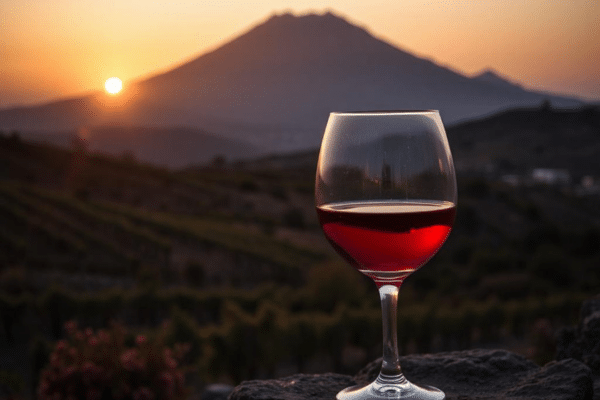Sicily, for me, is a controversial land; one must experience a full cycle of the seasons to understand it: harsh but beautiful, arid but lush, scents of orange blossoms and gorse growing on soils of lava and lapilli. While boasting a very ancient winemaking tradition, it is a region that prides itself on a rich culinary art to the level of which the quality of wine production has only recently risen, thanks to an increasing focus on sustainability in viticulture. I land in Catania on a late spring day. I am met by Sasà, the father of a friend of mine, a native of Catania, who is happy to accompany me on a tour of wineries in the land of his grandparents. We leave the airport heading toward ‘a Muntagna, as the locals use to call the volcano, as a sign of respect and gratitude.
Sasà explains to me that, during Muslim rule, this area was called Demon Valley because, legend has it, Etna was inhabited by demons and the volcano was considered the gateway to the underworld. Let’s talk about how the Arabs, although not wine producers, did good for local viticulture with the introduction of zabibib (zibibbo or Muscat of Alexandria), as well as new crops that today are the basis of local gastronomy. Conversely, the hand of my Roman ancestors fell on the whole area like a cleaver, extirpating vines to make Sicily the granary of Italy. This is perhaps the most controversial area of the island because of its climatic and environmental characteristics that range from the sultry heat of the coast to the snow of the cold winters on Mount Etna. This area is home to Italy’s oldest vineyards, some a hundred years old and free-range, and I look forward to seeing them. The semicircle around the crater is divided into districts, all characterized by silica-rich soils but each with its own specific component that makes it unique. The succession of volcanic eruptions over the centuries has transformed the soil, which in some areas is gravelly and pebbly, in others rich in iron, aluminum and calcium; also influencing the crops are the different exposures and altitudes that make each slope a microclimate unto itself. We head to the eastern slope where I think I will find a gray, gloomy desert heath; to my amazement, I find myself inside a palette of colors, among lava flows that contrast with lush vegetation. The vineyards lie between 400m and 800m asl, halfway between crater and sea. Soil rich in minerals, sea breezes and significant temperature swings between day and night make this slope the home of white grapes with high fixed acidity, first and foremost the Carricante grape, an indigenous variety at the base of the Etna Bianco DOC, whose acidity is muted only by complete malolactic fermentation. The grape variety’s name derives from the dialect expression u carricanti, due to its bounty of fruit capable of filling carts during the harvest. Only recently has its production been limited with firm pruning to favor quality at the expense of quantity. In the glass I find the greenish reflections of the local vegetation to back up a pale straw yellow; on the nose come the typical notes of flowers and fruits of the south: orange blossom, citrus and hints of anise that I also find in the mouth where that acidity typical of the grape variety rushes vigorously and where I find the savoriness of the sea breeze. Aging in steel enhances these characteristics, accentuating their freshness, while the passage in wood softens them, giving the wine greater olfactory complexity. We continue to the northeast slope where I find a surreal landscape. Brooms, junipers, and violets contrast with the blackness of the lava rock. On one side, I see the peaks of pines, chestnut trees and oaks peeping out, and on the other, the terraces sloping toward the coast are enriched with the colors of local crops such as olive, citrus and almond trees, to which the deep blue of the sea is the background.
Sasà explains to me that in recent years, some enlightened winemakers have chosen to recover native grape varieties by enhancing the properties of the soils that, although suffering from inconstant productivity, give wines absolutely original organoleptic characteristics. By following ancient farming practices and placing them side by side with modern ones, they have arrived at results of excellence. This is the case with Minnella Bianca, an indigenous grape variety that is difficult to adapt to other geographical areas. It owes its name to the oblong shape of the berry, which resembles the shape of a minna, or udder. Even more striking is the case of Nerello Mascalese, native to the Mascali plain, now grown on the slopes of the volcano mostly in the alberello system, an ancient cultivation system introduced by the Greeks that allows the plant to be sheltered from the wind and to maintain the right soil moisture. Often used in blends with other varieties in the region, here it tends to be vinified pure. We are between 500m and 800m asl on soils with a strong mineral component. From the coast, the sea breeze comes to mitigate the temperature and the temperature range between day and night can reach 25° in the veraison season helping the color development and anticipating the aromatic profile of the grapes. The season does not allow me to see the clusters ripen so I go for the characteristic light-blue color of the berries in my glass. I notice that the light ruby red tends toward garnet, almost indicating the ability to age elegantly. To make it less transparent, a small percentage of Nerello Cappuccio, an indigenous grape variety richer in chromatic substances, is allowed in the Etna Rosso DOC. The nose tells of the territory: decisive mineral scents, hints of aromatic herbs and important spicy notes conferred by the local spontaneous vegetation; in the mouth I find the same aromas again but I am overwhelmed by an important freshness overtaken by sapidity and a persistence that I wish would never end. Among the local wineries that stand out for quality and commitment, the one that most expresses the territory is undoubtedly I Vigneri di Salvo Foti with its project to enhance native cultivation using production methods that respect the environment and people. Visiting the Etnean palmento (an ancient cellar built in lava stone where grapes were turned into wine) is an effective way to understand the life of the vigneri and how tradition, understood as the set of knowledge and values, is a distinctive element and an added value for local viticulture. Sasà says a visit to the Benanti winery, the only one to make pure Minnella Bianca wine and known for having patented 4 indigenous yeasts used in the fermentation stages, is a must. Benanti breeds Nerello Mascalese on 3 different slopes of the volcano; I treat myself to a horizontal tasting of Etna Rosso DOC in search of the peculiarities of the 3 terroirs. The common characteristic is the pure vinification of the grape variety, which, after 12 months in French oak tonneaux, makes a passage in steel before refining in the bottle. In contrada Dafara Galluzzo (to the north), the vines are bush-trained at 750 meters above sea level, while in contrada Cavaliere (to the southwest) there are vines about 50 years old grown as espaliers; the climate is mountainous, humid and well ventilated.
In both glasses I find scents and aromas typical of the grape variety and firm but velvety tannins. In the Etna Rosso DOC contrada Monte Serra (to the southeast) different organoleptic characteristics emerge: fruity notes are accentuated on the nose, in the mouth the freshness returns to prevail over the savoriness and the palate is caressed by a noble tannin. Monte Serra enjoys a privileged position; the less extreme climate and high temperature range give the wine intense aromas and freshness. Raised high in the hills on sandy soils rich in ripiddu (lapilli), the vines are also 100 years old resulting in low grape yields and great variety of aromas that are concentrated in the few berries destined to become must. The result is a complex wine with a full, persistent and elegant taste. Before returning to the airport, we stop to taste an arancino with swordfish ragout paired with an Etna Bianco DOC. It seems a risky choice and instead the orange blossom aroma goes perfectly with the fish and the acidic backbone dampens the sweet tendency of rice, breadcrumbs and tomato pulp, as if to confirm the harmony between environment and traditions. Now ‘a Muntagna appears generous to me, I smile thinking that the demons had found paradise. I am reminded of a phrase by Salvo Foti, a perfect synthesis of my experience, of lives and of life, in the land of Etna:
“Man as well as a sapling vine must always have his roots firmly in the past (…), live (…) in harmony with all living beings, (…) with nature, with our Earth, of which we are part and not above.”



